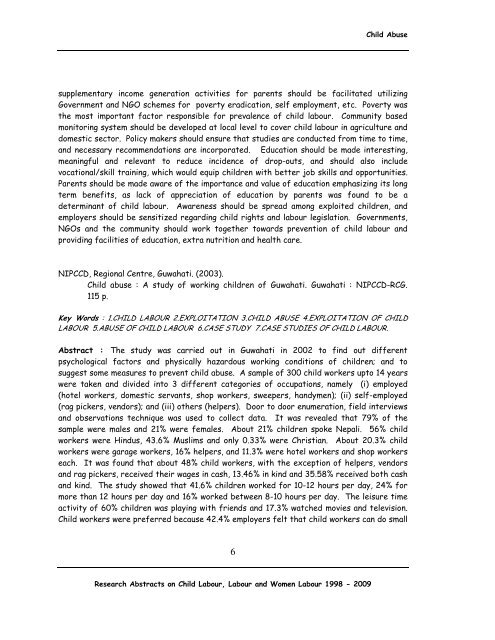Research Abstracts on Child Labour Women Labour - Nipccd
Research Abstracts on Child Labour Women Labour - Nipccd
Research Abstracts on Child Labour Women Labour - Nipccd
Create successful ePaper yourself
Turn your PDF publications into a flip-book with our unique Google optimized e-Paper software.
6<br />
<str<strong>on</strong>g>Research</str<strong>on</strong>g> <str<strong>on</strong>g>Abstracts</str<strong>on</strong>g> <strong>on</strong> <strong>Child</strong> <strong>Labour</strong>, <strong>Labour</strong> and <strong>Women</strong> <strong>Labour</strong> 1998 - 2009<br />
<strong>Child</strong> Abuse<br />
supplementary income generati<strong>on</strong> activities for parents should be facilitated utilizing<br />
Government and NGO schemes for poverty eradicati<strong>on</strong>, self employment, etc. Poverty was<br />
the most important factor resp<strong>on</strong>sible for prevalence of child labour. Community based<br />
m<strong>on</strong>itoring system should be developed at local level to cover child labour in agriculture and<br />
domestic sector. Policy makers should ensure that studies are c<strong>on</strong>ducted from time to time,<br />
and necessary recommendati<strong>on</strong>s are incorporated. Educati<strong>on</strong> should be made interesting,<br />
meaningful and relevant to reduce incidence of drop-outs, and should also include<br />
vocati<strong>on</strong>al/skill training, which would equip children with better job skills and opportunities.<br />
Parents should be made aware of the importance and value of educati<strong>on</strong> emphasizing its l<strong>on</strong>g<br />
term benefits, as lack of appreciati<strong>on</strong> of educati<strong>on</strong> by parents was found to be a<br />
determinant of child labour. Awareness should be spread am<strong>on</strong>g exploited children, and<br />
employers should be sensitized regarding child rights and labour legislati<strong>on</strong>. Governments,<br />
NGOs and the community should work together towards preventi<strong>on</strong> of child labour and<br />
providing facilities of educati<strong>on</strong>, extra nutriti<strong>on</strong> and health care.<br />
NIPCCD, Regi<strong>on</strong>al Centre, Guwahati. (2003).<br />
<strong>Child</strong> abuse : A study of working children of Guwahati. Guwahati : NIPCCD-RCG.<br />
115 p.<br />
Key Words : 1.CHILD LABOUR 2.EXPLOITATION 3.CHILD ABUSE 4.EXPLOITATION OF CHILD<br />
LABOUR 5.ABUSE OF CHILD LABOUR 6.CASE STUDY 7.CASE STUDIES OF CHILD LABOUR.<br />
Abstract : The study was carried out in Guwahati in 2002 to find out different<br />
psychological factors and physically hazardous working c<strong>on</strong>diti<strong>on</strong>s of children; and to<br />
suggest some measures to prevent child abuse. A sample of 300 child workers upto 14 years<br />
were taken and divided into 3 different categories of occupati<strong>on</strong>s, namely (i) employed<br />
(hotel workers, domestic servants, shop workers, sweepers, handymen); (ii) self-employed<br />
(rag pickers, vendors); and (iii) others (helpers). Door to door enumerati<strong>on</strong>, field interviews<br />
and observati<strong>on</strong>s technique was used to collect data. It was revealed that 79% of the<br />
sample were males and 21% were females. About 21% children spoke Nepali. 56% child<br />
workers were Hindus, 43.6% Muslims and <strong>on</strong>ly 0.33% were Christian. About 20.3% child<br />
workers were garage workers, 16% helpers, and 11.3% were hotel workers and shop workers<br />
each. It was found that about 48% child workers, with the excepti<strong>on</strong> of helpers, vendors<br />
and rag pickers, received their wages in cash, 13.46% in kind and 35.58% received both cash<br />
and kind. The study showed that 41.6% children worked for 10-12 hours per day, 24% for<br />
more than 12 hours per day and 16% worked between 8-10 hours per day. The leisure time<br />
activity of 60% children was playing with friends and 17.3% watched movies and televisi<strong>on</strong>.<br />
<strong>Child</strong> workers were preferred because 42.4% employers felt that child workers can do small

















